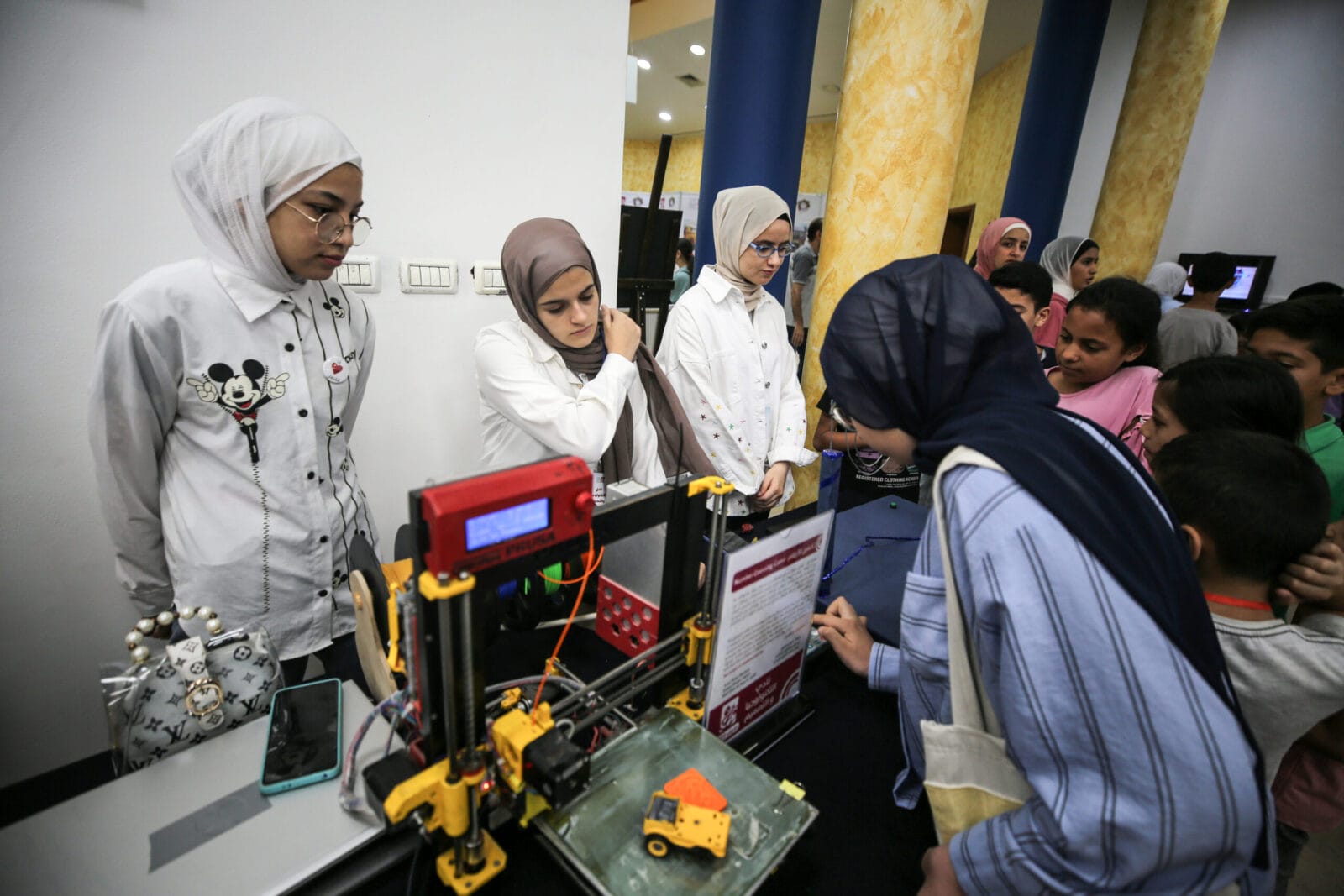Unpacking the Gender 'Paradox’ Behind Arab Women in Tech


Compared to women in the United States and most European countries, Arab women are highly represented in Information and Communication Technology (ICT) and related computing fields.

In fact, six of the ten countries with the highest rates of women studying ICT are in the Arab world, according to UNESCO data.
This disparity has not gone unnoticed by researchers, specifically in the field of psychology, who have labeled it a “gender-equality paradox.” That was the phrase used in a 2018 study published in Psychological Science, which attempted to explain why women pursue STEM fields in greater numbers in countries with less “gender equality,” according to measures like the World Economic Forum’s Gender Gap Index.[1] The author’s conclusion: “low prospects for a satisfied life may be an incentive for girls to focus more on science in school and, as adults, choose a career in a relatively higher paid STEM field.”[2] In other words, women only pursue STEM careers because the odds are stacked against them.
Setting aside the issues with gender equality measures used in these studies—which often overemphasize paid employment and indirectly devalue female-dominated fields—framing the outcome as a paradox obscures women's agency and the diversity of their experiences across both global South and global North contexts.
Curious about the relative success of Arab women in pursuing computer degrees, in 2017 we put together an interdisciplinary team of researchers to design and carry out a targeted survey of members of the organization Arab Women in Computing. 521 students, academics and practitioners working in the computing and tech fields, representing 17 Arab nationalities, responded. The study was supplemented by in-depth, open-ended interviews with 27 women at various stages in their careers.
Rather than starting with flawed metrics of gender inequality, centering Arab women’s own experiences and trajectories in computing and technology reveals a wide range of reasons for their participation in these fields. While economic opportunity mattered, more important were a desire for personal growth, independence and, above all, a desire to improve their societies. This richer and more positive set of motivations challenges reductive explanations that focus solely on economic factors and reproduce Orientalist assumptions about the condition of women in the region.
For the past two decades, female students in the Arab world have outperformed their male counterparts on global standardized tests of math and science abilities.
Two prominent exams are used to track global rankings in STEM at the K-12 level: the Trends in International Mathematics and Science Study (TIMSS, a standardized test first administered in 1995 to fourth and eighth graders in more than 40 countries) and the Programme for International Student Assessment (PISA, a test of math, reading and science literacy for 15-year-olds first administered in 2000 by the OECD). For decades, these tests and their global rankings have functioned as a measure of educational progress around the world, especially in math and science, in what some have termed the educational “race to the top.” Like all standardized tests, these assessments have their ideological baggage and unintended effects. But their power has become so pervasive in educational policy circles that some countries have organized their curricular timelines and educational goals around the goal of achieving higher national rankings.[3]
In the Middle East, these tests have become a proxy for educational quality...Since they were first administered in the region, girls have outperformed boys in math and science in the overwhelming majority of Arab countries.
In the Middle East, these tests have become a proxy for educational quality, and the gendered patterns in math and science have surprised researchers. Since they were first administered in the region, girls have outperformed boys in math and science in the overwhelming majority of Arab countries. For example, in 2019 the TIMSS test was administered in 68 countries. In eighth grade science, girls outperformed boys in only 15 countries—eight of them were Arab, and the list also included Turkey and Iran. In math, girls outperformed boys in seven countries, five of them Arab with Iran included again.
Beyond K-12 testing, Arab women also pursue post-secondary STEM degrees at some of the highest rates globally. In OECD countries, women, on average, represent slightly less than a third of those who enter STEM fields.[4] And when it comes to specific fields, these discrepancies become even more pronounced.[5] For example, Europe has the lowest numbers of female graduates in ICT (compared to the Middle East and North Africa, which leads globally).
Computer science and information sciences saw the share of female graduates in the United States rise to around a third in the 1980s with a high of 37.1 in 1983–1984. Subsequently, the rate declined for over two decades, to a low of 17.6 in the early 2000s. This trend has been slow to reverse in the 2010s, despite over two decades of interventions aimed at increasing the numbers. By 2021–2022 the rate had crept up slightly to 22.6 percent.[6] The underrepresentation of women computer scientists in the United States is particularly notable given that tech has dominated the country’s economic landscape over the past two decades, leading to an explosion in jobs.
Western European countries do not fare better. Europe has some of the lowest rates of female achievement in ICT globally. According to data gathered by the OECD in 2014, European women on average earned less than 20 percent of the bachelor’s degrees in computer science in ten of the 12 European countries for which data was gathered. The only exceptions were Portugal and Sweden.[7]
In the Arab world, the picture is strikingly different. According to our data, women represented at least a third of undergraduates enrolled in computer science across a range of fields, including computing, applied computing, artificial intelligence, computer application development and software development—and the numbers were typically higher. While their participation did vary from year to year, countries as diverse as Egypt, Jordan, Saudi Arabia and the UAE had relatively high rates of enrollment across multiple years.
The gender equality paradox imposes deficit thinking to explain why the disparities and inequalities in the Global North are not found elsewhere in the world. But understanding Arab women’s participation in STEM fields in terms of what is lacking in their societies erases their perspectives and reinforces stereotypes of women in the region as passive and oppressed. Instead, a number of structural and individual factors drive women’s participation.
One of these factors is tracking. A number of Arab countries have some kind of tracking system in place that creates a pipeline through which students who have strong quantitative skills are tracked into STEM fields. Though rates of tracking vary by country, the majority of women in our sample were tracked into math and science for secondary education.
But tracking doesn't explain the high prevalence of women in ICT and computing, specifically. Students with strong quantitative skills have many choices when it comes to completing secondary degrees in math and/or science. As such, to assume that tracking fully explains why Arab women are more likely to end up studying computing or ICT ignores the degree of personal agency that many women articulated: 81.5 percent of our survey respondents said their own preferences was the most important factor shaping their enrollment in an ICT or computing program.
While individual choice was an overwhelming factor explaining their decisions, many women also discussed the positive roles that families, teachers and mentors played in encouraging them to pursue computing and ICT. Amira, a tech entrepreneur from Saudi Arabia, who started in pre-med but then decided to transition into computing, for example, explained, “While I was pre-med [my father] encouraged me to take computer science classes, because he said it was the wave of the future.”
When women recounted situations where their family members discouraged them from studying computing, often this hesitance was because individuals were less familiar with the field and hoped that their daughters would pursue other careers in STEM such as medicine or pharmacology. Rania, an entrepreneur from Lebanon laughed when she explained that her father regretted that she was studying engineering rather than medicine. “I told my father I could not look at blood,” she said. Later in the interview she went on to explain the supportive role he had played vis-a-vis her entrepreneurial ambitions.
The Arab region has among the lowest rates of paid female employment globally. But the data show a very different pattern for women with high levels of education. While the overall labor force participation rate of Arab women is only 18 percent, among those with post-secondary education, the rates range from a low of 24 percent in Sudan to a high of 74 percent in Tunisia, with many countries clustered around 60 percent—just a few percentage points below the US rate of 68 percent.[8] Certainly employment was a major aim of most if not all of our interviewees.
In a region where youth unemployment rates are unfortunately quite high, having technical skills can provide an employment edge. Among those we interviewed, a love of computing and an interest in finding paid work were both important motivators. Reham, a network engineer we spoke with in Bahrain, described struggling to find a job in the 1990s with a bachelor’s degree in business. "I tried to fill my time and do something, so I started to study A++, which is a technical course related to the computer itself," she said. In 2000, she began to study computer science, before shifting to network engineering, a path which led to her current role in that field.
Aside from the challenge of unemployment, our interviewees recounted experiencing a range of other work-related difficulties: co-workers who doubted their abilities or instances where they faced openly sexist bosses or clients. One woman recalled a client refusing to participate in a training that she was conducting, preferring “a less qualified colleague because he was a man.”
Women also pointed to gendered socialization as an issue. One interviewee explained that for much of her career, she was passive about negotiating her salary, which she saw as a function of gender norms. She explained that she only started negotiating her salary when she became CEO of a manufacturing company based in Lebanon. “Part of the problem with women is the way they are raised,” she said. At the same time, she is optimistic that things are changing: “I see the younger generation is raised differently.” It should be noted, however, that women's hesitation when it comes to negotiating salaries is not unique to the Middle East. Researchers have documented this problem across a range of countries and professions. And recent studies suggest that even when women are more likely to negotiate, they are less successful.
The academic literature indicates that a lack of role models and mentors is another factor limiting women’s careers—one that may also contribute to women struggling to negotiate salaries and other work-related demands as effectively as men. Certainly, a number of those we interviewed expressed their desire for more and better mentors. At the same time, many of our older interviewees were proud of the role they had played in mentoring the next generation of computing professionals. Renad, a Palestinian software engineer working in Lebanon, discussed the absence of sufficient mentorship in her own experience and why it is important to her to mentor younger women. “They can help you with harassment issues," she told us. “Men may think it’s a joke. Only women know what it feels like.”
The challenges and gendered biases women encountered in the workplace and during their educational journey were not specific to STEM or computing, nor were they geographically limited to the Middle East and North Africa. In fact, many recalled experiences they had in Europe, the United Sates and other more so-called gender equal societies, where they experienced not only gender discrimination but were also subject to anti-Arab or anti-Muslim stereotypes. The latter was particularly the case for women wearing the hijab.
For some women, their first encounter with gender stereotypes around computing was when they left the region.
For some women, their first encounter with gender stereotypes around computing was when they left the region. As one woman from the UAE explained, “It was not until MIT that I first experienced discrimination.” Another woman, Nour, who works as a systems manager for a major transportation hub, remembers first becoming aware of gender stereotypes related to her expertise when she traveled abroad for a conference and was treated as an exciting novelty. She was frequently approached to be interviewed and everyone wanted to talk about Arab women in computing. It made her realize, in her words, that when it comes to the field, “the Arab world was unique.”
While many women have faced challenges throughout their careers, the path has also been rewarding, and many of our interviewees reinforced that the technical aspects of the job are a part of what they relish. Manal—a computer science graduate from Jordan who started her own company—for example, complained about how her day-to-day tasks had shifted to sales and meetings when she transitioned to owning her own company taking away her time to program. “I don’t find the time to write anything, but I still love it," she said. "I wouldn’t be upset if I gave up the company to someone else and I just wrote code.”
Indeed, the vast majority of the women we spoke to emphasized non-monetary factors as particularly important. Rawan, for example, is a software engineer from Jordan. She described a project she was involved in focused on creating more internet content in Arabic. The project was responding to the dearth of Arabic language material that provides, in her words, “in-depth, critical articles or content pieces covering different aspects of technology and how we use technology to communicate, or the intersections of technology and politics.” Her reasons for participating were simple, “I want to be part of it.”
The experiences recounted by these women—like the data on STEM more broadly—highlight patterns that challenge conventional understandings of gender and professional trajectories in supposedly male-dominated fields. Rather than viewing Arab women’s entry into and success in these fields as paradoxical, researchers would do well to reverse their gaze and ask what can be learned about educational and employment outcomes—both in the global South and global North—by examining the exeriences and motivations of Arab women who choose to study and work in STEM professions.
Read the previous article.
Read the next article.
This article appears in MER issue 314 “New Gender Frontlines.”
[Fida Adely is an associate professor at Georgetown University and the Clovis and Hala Maksoud Chair in Arab Studies. Jennifer C. Olmsted is a professor of economics and the director of Middle East Studies at Drew University. Sana Odeh is a clinical professor of computer science at New York University. She played a major role in establishing the Computer Science Department at NYU Abu Dhabi and founded the organization Arab Women in Computing (ArabWIC).]
[1] Gijsbert Stoet and David C. Geary, "The Gender-Equality Paradox in Science, Technology, Engineering, and Mathematics Education," Psychological Science 29/4 (2018), p. 591.
[2] Ibid.
[3] Clara Morgan, "The spectacle of global tests in the Arabian Gulf: a comparison of Qatar and the United Arab Emirates," Comparative Education 54/3 (2018), pp. 285–308.
[4] Silvia Montoya, “New UIS Data Show That the Share of Women in STEM Graduates Stagnant for 10 Years,” World Education Blog, April 25, 2024.
[5] Susan Schneegans, Tiffany Straza and Jake Lewis, “To Be Smart, the Digital Revolution Will Need to Be Inclusive,” In UNESCO Science Report: The Race against Time for Smarter Development (2021), pp. 118–19.
[6] Digest of Education Statistics, “Degrees in Computer and Information Sciences Conferred by Postsecondary Institutions, by Level of Degree and Sex of Student,” NCES, November 2023.
[7] Kathleen J. Lehman, et al., “Global Participation in Undergraduate Computing: A Review and Agenda for Research,” The Wiley Handbook of Gender Equity in Higher Education, eds. Nancy S. Niemi and Marcus B. Weaver‐Hightower (Wiley, 2020), pp. 289–313. Wiley, 2020.
[8] World Bank, “Labor force participation rate, female (% of female population ages 15+) (modeled ILO estimate),” Accessed May 10, 2025; World Bank Gender Data Portal, “Labor Force by Level of Education (%),” Accessed January 31, 2025.








